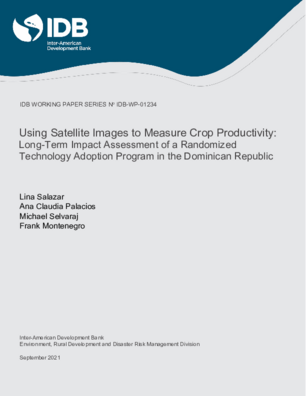Using Satellite Images to Measure Crop Productivity: Long-Term Impact Assessment of a Randomized Technology Adoption Program in the Dominican Republic
Date issued
Sep 2021
Subject
Crops;
Technology Adoption;
Productivity;
Impact Evaluation;
Irrigation and Drainage;
Agricultural Research
JEL code
Q00 - Agricultural and Natural Resource Economics • Environmental and Ecological Economics: General: General
Country
Dominican Republic
Category
Working Papers
This study combines three rounds of surveys with remote sensing to measure long-term impacts of a randomized irrigation program in the Dominican Republic. Specifically, Landsat 7 and Landsat 8 satellite images are used to measure the causal effects of the program on agricultural productivity, measured through vegetation indices (NDVI and OSAVI). To this end, 377 plots were analyzed (129 treated and 248 controls) for the period from 2011 to 2019. Following a Differencein-Differences (DD) and Event study methodology, the results confirmed that program beneficiaries have higher vegetation indices, and therefore experienced a higher productivity throughout the post-treatment period. Also, there is some evidence of spillover effects to neighboring farmers. Furthermore, the Event Study model shows that productivity impacts are obtained in the third year after the adoption takes place. These findings suggest that adoption of irrigation technologies can be a long and complex process that requires time to generate productivity impacts. In a more general sense, this study reveals the great potential that exists in combining field data with remote sensing information to assess long-term impacts of agricultural programs on agricultural productivity.
Generative AI enabled




